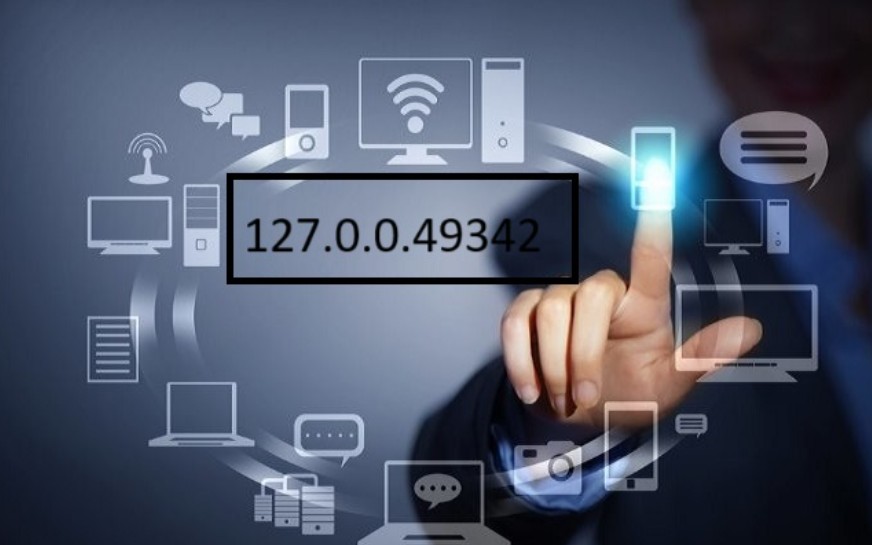What Is 127.0.0.1:49342, and Why Does It Appear in Local Connections?
The first time I saw 127.0.0.1:49342 pop up during a network check, I wasn’t sure whether it was something I needed to worry about. But as it turns out, it’s completely normal—especially in a local development or business IT environment.
Let me break it down for you.
Understanding the Loopback IP Address 127.0.0.1
The IP address 127.0.0.1 is known as the loopback address or localhost. It refers to the machine you’re using—your computer. Whenever a piece of software needs to communicate with your system internally, it often uses this IP.
Whether you’re testing a website or running internal tools, localhost ensures that no external network is involved.
What Does the Port Number 49342 Signify?
When I refer to 127.0.0.1:49342, I’m pointing to the IP address and a specific port number—in this case, 49342.
Ports are like doors that allow different types of network traffic to reach your machine. Port 49342 is a dynamically assigned port. That means it’s chosen temporarily by the system for a specific use, such as running a web app or connecting software locally.
When and Why Would I See 127.0.0.1:49342 Used?
You’ll often come across this format when:
-
Running local web servers (like Node.js or Apache)
-
Testing APIs or software features
-
Debugging applications
-
Monitoring software network activity
It simply means something on your system is talking to itself, using port 49342 temporarily.
How Does 127.0.0.1:49342 Work in a Localhost Environment?

When I run a development server or open a software tool, I frequently see the system use an address like 127.0.0.1:49342. Here’s why.
Role of Localhost in Development and Testing
In business, many web developers use localhost to build and test websites or apps before they go live. It’s safe, private, and requires no internet access. And yes—every time, it’s routing through 127.0.0.1.
How Dynamic Ports Like 49342 Get Assigned?
Unlike ports such as 80 (used for HTTP) or 443 (used for HTTPS), 49342 is a high-numbered port usually assigned temporarily. These are chosen from a pool known as ephemeral ports, typically ranging from 49152–65535.
So, when I see 127.0.0.1:49342, it just means a temporary, internal connection has been made.
TCP/IP and Localhost – Simplified for Non-Tech Business Users
Think of TCP/IP as the language your devices use to talk. The combination of 127.0.0.1 (IP) and 49342 (port) allows two parts of a program on your computer to speak privately and securely.
Is 127.0.0.1:49342 Safe for Business Networks?
Many business owners I speak to get nervous when they see unfamiliar ports or IP addresses. But this one’s no threat.
Can It Be Accessed from Outside Your Network?
Not. 127.0.0.1 is restricted to your machine. No one from the outside world can reach or exploit that address—unless they already have control over your computer.
Why Businesses Should Care About Localhost Traffic?
While it’s not risky by itself, understanding local traffic is key to:
-
Avoiding port conflicts
-
Ensuring proper software configuration
-
Detecting unusual internal activity (which could signal malware)
How to Monitor and Control Local Traffic on Dynamic Ports?
Here’s what I do:
-
Use Task Manager or
netstaton Windows to check open ports -
Use firewall rules to block certain behaviours
-
Set the software to use specific ports if needed
Real-World Use Cases – Where I’ve Seen 127.0.0.1:49342 in Action?

This address isn’t just for tech geeks—it’s used in business software every day.
Web Development Servers (e.g., Apache, NGINX, Node.js)
Most dev tools automatically bind to 127.0.0.1 and select a random port like 49342. This keeps your test site off the internet.
Software Applications Triggering Localhost Ports
Many business applications (accounting software, internal dashboards) use localhost ports to function behind the scenes.
Example: Port 49342 Usage in Debugging Tools
I once used a browser-based debugging tool that launched on 127.0.0.1:49342. It wasn’t listed in my firewall, but it was completely safe.
Troubleshooting and Managing Localhost Ports Like 127.0.0.1:49342
Now and then, I run into conflicts or errors. Here’s how I fix them.
Common Issues and Quick Fixes
-
Port already in use → Restart the software or assign a different port.
-
Cannot connect to localhost → Check firewall or antivirus software.
-
Connection refused → Ensure the program is actively running.
Tools to Inspect Local Ports and Services
Here are a few tools I rely on:
-
netstat(Windows, macOS, Linux) -
TCPView (Windows GUI tool)
-
Activity Monitor (macOS)
-
Wireshark (for deep analysis)
Managing Firewall Rules and Local Configurations

To keep things secure:
-
Whitelist only the necessary ports
-
Disable services not in use
-
Use admin permissions sparingly
Table – Summary of Key Technical Terms
| Term | Meaning |
|---|---|
| 127.0.0.1 | Loopback IP address used for localhost |
| Port | A virtual endpoint for network communication |
| 49342 | A dynamic (ephemeral) port number |
| Localhost | Refers to the local machine |
| TCP/IP | Communication protocol suite |
| Loopback | Internal connection to the same device |
Final Thoughts – Why Understanding 127.0.0.1:49342 Matters for Every Business Owner?
You might not think about localhost or 127.0.0.1:49342 daily, but they’re quietly powering your internal tools and tests.
As a business owner or manager, knowing what they do helps you:
-
Communicate better with your tech team
-
Spot unusual activity early
-
Maintain a more secure and stable IT environment
Whether you’re running a simple dashboard or managing a team of developers, it pays to understand the inner workings of your local systems—even the strange-looking ones like 127.0.0.1:49342.
FAQs About 127.0.0.1:49342 and Localhost Networking
What’s the Difference Between 127.0.0.1 and Localhost?
Functionally, none. 127.0.0.1 is the numerical address; localhost is the alias.
Is Port 49342 Always Safe to Use?
Yes, as long as it’s used internally and not exposed to public networks.
Can I Block or Reroute a Port Like 49342?
Definitely. Most firewalls and software allow you to configure port settings manually.

Leave a Reply